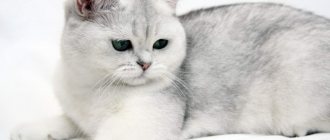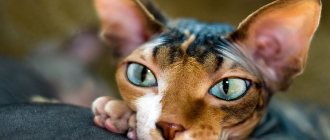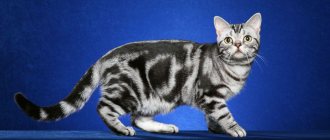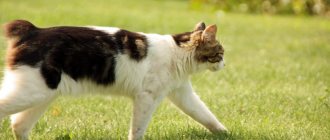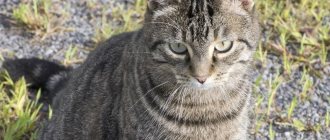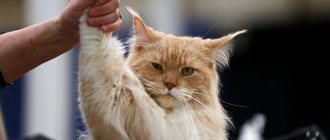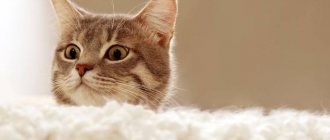British merle color: features of the breed
The first cat show, held in 1879 in London, was attended by the British. Since then, plush animals have gained considerable popularity, as kittens were actively bought by foreign breeders and taken outside the country. The breed, despite its long existence, was officially recognized only in 1950.
At the end of the 70s of the last century, a document was created prohibiting breeding them with any other felines. And in 1980, aristocrats received recognition from the FCA Association.
According to the standard, a purebred individual must have:
- Proportional, strong body with clearly developed muscles, squat and dense.
- Large head with wide-set, medium-sized ears (rounded tips).
- A fold around a short massive neck.
- Big round eyes. The color of the iris is predominantly amber-orange, less common is green and blue. Babies have gray-blue eyes, changing color as they grow older.
- Wide chest.
- Well-defined cheekbones, pronounced cheeks, developed chin and wide nose.
- Thick undercoat.
- The coat is short, dense with hairs of equal length. It feels like plush.
- Neat, strong, rounded paws corresponding to the body type.
- Fleshy, medium-length tail with a rounded tip and a wide base.
The British are distinguished by their long lives, often reaching 15-20 years of age. The weight of an adult animal ranges from 5 to 8 kg; height is not indicated in the standard, but must correspond to a dense constitution.
How to choose a kitten
You should know that even newly born kittens already have characteristic patterns on their fur. The ornament, however, is often weakly expressed, but always contrasting. Saturation appears within a couple of months. In any case, at the time of sale, all obvious signs of marbling are already present.
Don't trust those who claim that babies always have a uniform color after birth and only then do patterns appear on their coats - most likely, you are simply being scammed.
Otherwise, the selection criteria remain the same as in general cases, that is, kittens should be:
- active;
- curious;
- not shy;
- with dry eyes and a nose without snot;
- beautiful shiny fur.
Features of color and types of harlequin British
During the First and Second World Wars, the British population was in danger of extinction. To quickly restore the livestock, breeders added fresh blood, crossing English immigrants with Persians, exotics, Russian Blues, Burmese, Scottish Folds, and Chartreuses.
Be sure to read:
Character of British cats: main traits, behavior, bad habits, pros and cons of the breed
As a result of experiments, the breed was improved, color variations expanded. Today there are more than 200 species.
The most popular are:
- Plain (solid) – basic. These include black, chocolate, cream, blue, red, white, purple.
- Tortoiseshell. This species is characterized by spots of two colors, evenly distributed throughout the coat.
- Particolors. The combination of white with the main color, this group includes harlequins, bicolors, etc.
- Golden - appeared recently, divided into shaded and ticked.
- Smoky – characterized by balayage hair coloring, pigmented only at the ends and not dyed at the root. Available in two versions - chinchilla and smoky.
- Color point - light main fur with dark spots in certain places, was inherited by the British from the infusion of Siamese blood.
- Patterned (tabby) - the standard recognizes the brindle, ticked, marbled, spotted variant.
- Silver – available in ticked and shaded form.
The tabby color to which the marbled variety belongs takes its name from the province of Attabiya (Baghdad, Turkey), famous for the production of striped fabric. It is generally accepted that such wool is the result of the presence of forest cats or Nubian dun cats in the British family.
Silver and shaded
Shaded is a very bright and noticeable color of cats, which has gained particular popularity among lovers of the British and Persians. The highlight is that each hair is only partially colored, and the base is much lighter than the painted area. It seems as if a thin translucent veil was thrown over the cat. In motion, this coloring is especially impressive - the color reveals itself with every step of the owner of a rich fur coat.
British chinchilla color (1/8 of the hair is dyed, the very tip)
READ What to do if your cat is bleeding from the anus
British shaded color (one third of a hair is dyed)
British shaded cameo
A silver tabby color is called when the darkened tips of the hairs form a pattern. Most of the hair at the base is still very light (white to slightly grayish for black cats and slightly creamy for red cats).
Silver spotted Siberian
Smoky cats look impressive and unusual - the entire hair is dyed, except the base. At first glance, the color looks like a solid color, but only until the cat begins to move - the hairs fall apart, revealing the snow-white base of the coat.
Siberian black smoke
Smoke “on the contrary” is the silvered coat of Russian Blues, Nibelungs and some other breeds. With this color, the fur coat looks monochromatic, but the very tip of the hair is bleached. It seems as if the cat's fur is covered with frost or strewn with snowflakes.
Character and habits of marbled British
The British are intellectuals, they can determine the owner’s mood by their voice and gestures, and by a person’s elevated tone they quickly realize that they are doing something illegal. Imposing, dignified, calm cats are not prone to aggression, rancor, or mischief, but at the same time they know how to protect their boundaries and will not allow their person to be treated unceremoniously.
They are independent, you should not expect annoying affection, stormy meetings, or lightning-fast appearance at the first call from them. It seems that this cat has “his own person” and patronizes him condescendingly. But behind this external equanimity lies a tender devotion to all family members.
They get along well with other cats and dogs, as long as they don't pester them too much. They do not need constant company; the British can be called the introverts of the cat world.
Character
Cats of the British breed have a calm disposition, this is a truly English character: restraint, aristocracy, delicacy and unobtrusiveness. They are devoted to their owner, despite their independence, and love to stay at home. As a rule, these cats do not run away from home and do not appear in lost ads.
Marbled British do not show aggression even if something is done against their will. Many representatives of this breed are very playful and spontaneous, so they will need household equipment and toys to keep them. They do not like strangers, they rarely go into the arms of anyone except their family.
Caring for the British Marbled's coat
By nature, these cats are clean, they take good care of their fur, actively licking themselves, but to make the fur look perfect, human intervention is essential:
- Grooming is trusted to professionals; without proper experience, it is easy to ruin the appearance of your pet. This breed sheds profusely; grooming will significantly reduce the amount of hair in the house. In the summer, the procedure helps cats not suffer from overheating. The British should not be given sedatives before visiting the hairdresser, but due to their phlegmatic nature, they rarely show resistance.
- To comb, you need to purchase a rubber slicker brush or a comb with rounded teeth. Domesticated individuals shed longer and more heavily than their walking counterparts. You need to scratch your cat every day.
- It is not necessary to bathe this breed often; 2 times a year is enough. Water for bath procedures should be warm, about 30°C, washing products are selected taking into account color. Show cats are bathed more often, up to once every 1-2 months.
Be sure to read:
How to care for a British kitten: feeding, education, mating features, when to vaccinate
To prevent the appearance of fleas, preventive disinfestation should be carried out (the regularity depends on the duration of the drug specified in the instructions), and special insect-repellent collars should be put on the animal.
Health status
The Fold cat has many genetic diseases, which are not observed in the British marble cat. Such cats live up to 20 years, have strong immunity, and rarely get sick. However, they catch cold quickly if left in the cold or draft. As well as marbled, blue, black and white British kittens and adults may suffer from the following diseases:
Animals have a strong immune system, but can suffer from diseases such as obesity.
- Obesity. Representatives of the breed are lazy and sedentary, which contributes to excess weight. This negatively affects the cardiovascular system and joints.
- Cardiomyopathy. Characterized by thickening of the heart muscle and poor circulation.
- Hemophilia. This is a bleeding disorder that can cause prolonged bleeding and lead to anemia.
- Polycystic kidney disease. Cysts form on the organs, gradually replacing the parenchyma, which leads to dysfunction.
- Tartar. The merle shorthair is prone to plaque formation on the teeth, which is dangerous for the development of gingivitis and periodontal disease.
Features of mating marbled British
Cats in their first heat are not allowed to mate; the body is not yet ready to bear viable offspring. It is optimal to schedule the denouement for the third mating season. A partner should be selected in advance; for breeding, a candidate is sought in the club. It is advisable for a young female to be provided with a partner with experience.
Before this, both of them must be wormed two weeks in order to avoid infection of kittens with helminths during birth. The mark on comprehensive vaccination and rabies injection must be made no earlier than a month before the intended date and no later than a year. A cat's claws must be trimmed before mating.
During mating games, the female often slaps her gentleman in the face with her paw; such a preventive measure will help avoid eye injuries in case of an unsuccessful hit.
The cat is brought to the male, it is advisable to provide her with her own bowl, tray, transportation, where she can retire to rest. Some ladies need time to adapt to new conditions, but after an hour or two, instinct will prevail over caution.
Owners sometimes enter into written agreements on the temporary transfer of the animal into someone else’s hands, which also stipulates the conditions under which mating takes place (free of charge, for money, a maintenance kitten, etc.). The paper eliminates controversial issues in the future. If pregnancy does not occur, the other party should be notified.
Life in captivity
Marbled cats are easily tamed if they are introduced to captivity as children. However, when they become adults, they can demonstrate their wild nature or go back to their native jungle. These cats live in zoos in different countries, where there are about ten of them. Under good conditions, they give birth to cubs in captivity. It is recommended to house them in spacious enclosures with complex landscapes and numerous shelters. However, it is quite difficult to see a marbled cat in the zoo, since it comes out of its hiding place at night, when there are no more visitors. In the future, zoologists plan to expand the size of this population through breeding in zoos, but so far an official program for this has not been developed.
Zoologists plan to expand the marbled cat population by keeping it in zoos
People living in the habitats of the marbled cat sometimes bring this animal home. Many of these owners even managed to obtain cat hybrids from its domestic relative. Hybrids are viable, but rarely produce offspring.
Marbled cats are prohibited from being removed from their habitats. However, sometimes some individuals are still smuggled into Europe, where exotic animals are especially valued and in demand.
There is unconfirmed information that the marbled cat is kept in private menageries in Russia. Such presence of an animal is illegal, so it is not particularly advertised.
A friend of mine brought an interesting photo of a marbled cat from the Chinese zoo. And before that, she waited 2 days for this animal to emerge from its shelter. As the zoo worker explained to her, these animals sleep mainly during the day, so it is difficult to see them. The next day, my friend went to the zoo close to closing - she hoped that at dusk she would be able to see the cat. And fortunately for her, she succeeded - the animal looked out from its shelter, pricked up its ears, stood for a couple of minutes and disappeared into its shelter. During this time, my friend managed to look at the cat and even take a photo of it.
The Difficulties of Breeding British Marbleds
During pregnancy, which lasts 63 days, the cat should be fed well, but not allowed to overeat. Excess weight puts extra strain on the heart. Females usually give birth on their own. It is advisable for an inexperienced owner to agree in advance with the veterinarian about the possibility of a home visit in the event of an unforeseen complication.
Be sure to read:
Kitten weight by month: table, features for different breeds, how much they weigh at birth
Often, when crossing British cats, kittens are born that breeders, out of ignorance or for profit, sell as marbled, although in fact they are moiré. It is easy to distinguish one from another. Tabbies are patterned in a color different from the main one, and moire specimens are painted in a darker shade of the “base”; over time they will become monochromatic.
How to get marbled kittens
A recessive gene is responsible for this color, so to get tabby kittens it is necessary to mate parents with the same coat.
A merle litter can be obtained from the mating of a spotted individual with a brindle, two brindles, or a pair of spotted ones if they both carry the recessive gene.
Who are marble cats?
In the humid thickets of tropical forests lives a very beautiful and rare animal - the marbled cat (Latin name - Pardofelis marmorata). Until recently, scientists classified this species as a small cat, but more detailed studies of the animal’s DNA assigned the forest predator to another subfamily - big cats. According to some authoritative zoologists, the marbled cat is, as it were, a transitional link between these two subfamilies.
Meeting this beauty is a rare success
Surprisingly, modern researchers are unanimous in the opinion that this species is closely related to the well-known lynx, although in appearance these cats are completely different from each other. But they are very similar in anatomy to Far Eastern cats, with whom, although they live next door, they are very, very distantly related.
Not only in the scientific classification, but also in the real life of the wild beauty, there are still quite a few unsolved mysteries to this day. Probably, it is the marble cat herself who carefully protects her secrets from people. This unique species, like many other animals, has suffered a lot from human activity and cruelty - today there are no more than ten thousand individuals of the marbled cat left in nature, and its population is constantly declining.
Habitat
It is generally surprising that at least such a number of these wild animals have survived to this day - for many years people mercilessly exterminated the marbled cat for its beauty - nature gave it too spectacular a fur coat. The little predator was saved from complete disappearance by caution and distrust: she prefers to settle in impenetrable thickets and meet less people.
This girl is extremely cautious and distrustful
The marbled cat lives in the following countries of Southeast Asia:
- Bangladesh;
- Burma;
- Vietnam;
- India;
- Indonesia;
- Cambodia;
- China;
- Laos;
- Malaysia;
- Nepal;
- Thailand.
A small population of wild cats has a wide habitat
There are two phenotypically distinct subspecies: Pardofelis marmorata marmorata and Pardofelis marmorata chritoni. Despite its extensive range, the population density of the species remains extremely low. In each of the territories, only small islands have been preserved, where small populations of marbled cats live. Almost everywhere, the rare species is listed in the Red Book and Appendix I of CITES - it is protected at the legislative level.
Government regulations prohibit hunting this animal and exporting it abroad. Unfortunately, these rules are not always shared by poachers and smugglers.
External data
A luxurious tail is the first thing that immediately attracts attention when looking at a marble cat. It is unlikely that anyone else in the cat family has such an outstanding, large and beautiful tail - its length is equal to the size of its owner’s body. Why does a marbled cat need this beauty? The answer is simple. The thick and heavy, but very flexible tail plays an important role as a rudder and balance, allowing the predator not only to quickly climb trees and almost vertical rocks, but also to make dizzying jumps and pirouettes.
Cat-cat, why do you need such a big tail?
It is impossible not to notice the beautiful fur coat of a marbled cat - its thick short fur sparkles and shimmers, with black spots and stains on a golden background. They form a spectacular pattern, which many compare with the color of another rare animal - the clouded leopard. Such bright clothing, oddly enough, has camouflage properties - it helps the predator to camouflage perfectly during the hunt and saves it from stronger enemies.
The most contrasting pattern covers the back of the animal, it is lighter on the sides, and the fur on the belly is the least pigmented. The chaotic “marble” pattern gave the name to this type of animal. The paws and tail are dotted with black spots, which become larger on the tail. The ears of the night predator are interestingly colored - they have small rounded white spots on the back. The trick is that these spots in the twilight may appear to another animal as eyes staring intently at him - and discourage him from sneaking up on the marbled cat from behind.
Marble camouflage helps this little predator survive
If you don’t pick on the details, then this wild species can easily be mistaken for some exotic breed of domestic cat. And they are quite comparable in size, and in many other external features there are many similarities. But in reality, these are, of course, completely different animals, and the “cute” appearance of the marbled cat is very deceptive - it is a real wild animal, cruel and aggressive. Otherwise, she simply would not have had a single chance to survive where the laws of the jungle reign.
This sweet pussy is a daring and merciless predator
The body length of a marbled cat usually does not exceed half a meter, and the length of its wonderful tail is exactly the same. The animal's muscles are well developed. Upon closer examination, the cute muzzle demonstrates sense organs brought to perfection:
- huge, widely spaced expressive eyes - vision;
- alert round ears - hearing;
- large, butterfly-shaped nose - sense of smell;
- long hard mustache - touch.
All the hunter’s talents are “written” on the face of the marble cat
This is a rather small animal, although the modern classification classifies it as a large cat. Adult males usually weigh no more than five kilograms, and females even less.
What is also very impressive about the charming appearance of this baby is her fangs, which are not inferior in size to the fangs of a panther.
When this cute kitty opens her mouth, anyone can feel uneasy
Anomalies and features of merle color in the British
The color will not meet the standard if the following defects are present:
- expression - excessive contrast of stripes to the background;
- shaded – bleached marble;
- excessive ticking - blurred pattern;
- tornness - the stripes are not continuous, they form spots;
Excessive amounts of patterns and too wide stripes that dominate the light background will ruin the pet’s exterior.
British Marbles are not a separate breed. The final color of the cat will be formed by the year, the intensity, contrast, color saturation, and the shape of the dark lines will be fully manifested.
Charming plush minke whales are very popular among breed lovers and take leading places in competitions and exhibitions. Do you prefer the classic British or tabby fur?
BRITISH TABBY: COLOR STANDARD
British tabbies, regardless of the pattern on the coat, must have the following elements in their color (the exception is the ticked color - it has no pattern):
- the letter "M" on the forehead;
- “necklaces” on the chest;
- stripes on the paws;
- tail rings;
- one or two rows of spots on the belly;
- A contrasting tabby pattern is required;
- a light spot on each ear on the outside;
- eyeliner and nose to match the main color.
In British Whiskey cats, the main tone is silver, but the pattern can be made in different coat colors. The colors of British silver merle cats are encoded with the letter s (silver), which is added after the main color color, and in addition 22- means merle color.
Whiskas British dogs, regardless of coat pattern, must have the following elements in their color:
- the letter "M" on the forehead;
- “necklaces” on the chest;
- stripes on the paws;
- tail rings;
- two rows of spots on the belly;
- a contrasting marble pattern on the back is required;
- a light spot on each ear on the outside;
- eyeliner and nose to match the main color of the coat.
Silver merle Britons are based on bright silver with a grayish tint - just like real silver. Any yellow spots are rejected.
The eye color of a British silver spotted cat can be honey, orange, copper or green. The British silver tabby cat with green eyes is highly valued as it is a rarity among the British.
Possible problems
Breeders who specialize in breeding attractive marbled kittens of the British, Scottish, Bengal and other breeds very often encounter various kinds of problems, due to which they may end up with a color that does not meet all existing standards.
Most often, breeders face such problems.
- Expressiveness. With this problem, too bright a contrast can be seen between the print and the background on the cat’s skin.
- Shading. If such a deficiency occurs, then the color of the animal will look discolored, as if the marble was very worn.
- Excessive width of patterns. In this case, the background color is practically invisible through the patterns on the coat - this color is not considered the norm.
- Excessive ticking. This disease is externally manifested by a strong blurring of the pattern, which should still be more noticeable and expressive.
- The so-called torn pattern. With this problem, the stripes on the animal's skin may appear torn or even turn into specks of different sizes.
About the marbled Bengal cat, see the video below.
Existing colors of cats and cats
The variety of colors in cats depends on the breed and the work of breeders, who cross animals to highlight the rarest colors. Several genes are responsible for the formation of the palette.
In different combinations, under the influence of alleles, they create numerous variations of shades and patterns on the pet’s coat.
Solid
Solid color – it is characterized by uniform coloring along the entire length of the hair. In this form, there are animals with black, blue, chocolate, tortoiseshell, red and cream fur.
Solid white color. The dominant W gene suppresses all others and prevents them from appearing on the hair. Another variety of white is spotted (S). In this case, the canvas breaks up into separate white areas, but does not cover the entire surface of the body.
But the spots come in all sizes, sometimes so dense that they create the illusion of a solid color.
Albinos whose genotype contains the recessive trait c. When he takes the form of a sa, cats with blue eyes are born.
Tabby
The tabby pattern is expressed as a pattern on the coat (in the form of stripes or spots). It can be clear, contrasty or blurry. The latter option causes a marble effect. Gene A (agouti) is responsible for the tabby color. In the recessive state, the aa allele is suppressed and the pattern on the coat is not visible.
Beautiful tabby colors in cats are regulated by the T gene, which can appear in several variants:
- Pure T – tiger stripes, the traditional cat “outfit”.
- Ticked Ta, which is called “Abyssinian”, stands out in the form of a small rowan on the surface of the hair.
- Marble TbTb (classic) - blurry striped pattern.
- Spotted TsTs - there are suggestions that genes that have not yet been studied are responsible for the appearance of the “leopard effect”.
The designation of tabby cat colors is fixed in the names of some breeds (Asian tabby). In fact, such forethought is not needed - all animals have the A gene and can give birth to offspring with a spotted-striped pattern.
Color point
One of the unusual colors of cats is acromelanic, which belongs to the albino group. The color is notable because it depends on the cat’s body temperature. The most striking representative of this trend is the Siamese cat with a characteristic mask on its face and darkening on the ears, paws and tail.
Color point can be divided according to the color spectrum:
- almost black seal point;
- in gray-blue shades - blue point;
- lilac point - a mixture of gray and pinkish-red;
- a variety of red mask - red point;
- chocolate point;
- striped tabby masks;
- tortoiseshell acromelanic color-point;
- cream point.
Tortoiseshells
The group includes two-color cats, in which spots of two shades (except white) appear on their fur to an arbitrary degree of distinguishability. Most often we are talking about combinations of black and red, cream and blue, as well as lilac, fawn and cinnamon (cinnamon) in any combination.
The O gene is responsible for the color, which is combined in the dominant and recessive form Oo (red is not red). Tortoiseshell cats are found in almost all breeds and types of color: solid, tabby, color-point and others.
Colors with white
The most commonly considered cat color is tortoiseshell with the addition of white. Such animals are called patchwork or tricolor, and white dominates over other shades. As with “pure turtles,” the vast majority of this group are cats, and male cats are extremely rare.
Other combinations with white color are possible only if the spotting gene is present in the set of Ss alleles. In this case, the shades are mixed in random order, and the shape of the color and the location of the spots cannot be predicted in advance.
Silver
Very impressive color. The lower root part is bleached, and pigmentation appears only closer to the tip of the hair. This palette of shades is formed by gene I (inhibitor). The coloring of different areas of the hair depends on the activity of I.
- In the chinchilla color, the pigment appears only on 1/8 of the end of the hair.
- Shaded tones – 1/3 of the color.
- Among smoky ones, this ratio is 50x50.
- In the tabby group, the main coat color is white, with a silver pattern on top.
The processes of formation of the silver color have not been fully studied. Scientists suggest that additional genes are involved, which affect the individual coloring of each individual hair.
Tabby drawing: cat breeds that have it
In some cats, patterned coloring is the only one, while in others it is one of the possible ones.
Abyssinian cat
In this breed, the standard allows only one-color ticked color. The color of the short coat can be bright orange, copper, blue, etc. White spots on the chest and chin are allowed. The abdomen and limbs are lighter on the inside. There is a dark stripe running along the ridge to the very tip of the tail. The eyes are hazel, golden, sometimes green. The shade of the nose and feet corresponds to the basic tone. The color of the iris is often yellowish-orange, sometimes greenish.
Abyssinian cats have only one-color ticked fur
Video: Abyssinian beauties
https://youtube.com/watch?v=UQE0cZ-1a30
Singapura cat
The only permitted and acceptable color according to the standard is sepia agouti. The main background is close in color to ivory, with clear dark brown ticking. A dark stripe runs along the spine and to the tip of the tail. The chest, chin and belly are a warm, lighter, brownish shade. Residual pale stripes occur on the knees of the hind legs and on the inside of the forelimbs. The pads of the paws are brownish-pinkish, the shade of the nose is from delicate light salmon to rich dark. The iris of the eyes is colored in green, yellow and greenish-yellowish shades.
All Singaporeans are painted the same
Somali cat
The palette of ticked colors is quite wide (wild, sorrel, blue, black silver, fawn). Wools of a basic tone (red, blue, cream, white, etc.) with contrasting tips. A dark shade is observed along the entire spine and tail. The inside of the limbs and belly are a shade lighter. The color of the nose and paw pads varies from pink and bluish-gray to black. Eyes in bluish-green or yellowish-green tones.
The Somali cat has a dark stripe running down its back and tail.
Ocicat
Wild spotted coloring, in which darker contrasting spots are scattered against the main agouti background (beige, pale blue, red, etc.), with intermittent stripes along the ridge. On the sides and on the belly, the markings are slightly lighter and spaced a little less frequently. The skin on the nose is brick red or pink, the feet and tip of the tail are in contrasting tone. Eyes can be painted in any color, excluding blue and blue.
The Ocicat has a wild spotted coloration
Video: Ocicat cats
Pixie bob
Soft ticked wool of light warm brown tones, with a darker, distinct pattern of spots, small stripes or rosettes. The tip of the tail is almost black. The fur on the belly is spotted and lighter. Eye color ranges from light gold to brown or greenish gooseberry. The paw pads are dark brown or black, the nose is brick.
Pixie bobs have short tails
Video: pixie bob cats
The patterned tabby pattern is a classic cat coloration; it can be possessed by both outbred yard cats and purebred purebred animals bred through long-term selection.
A little history of the breed
There are several versions explaining the origin of the British cat breed. According to one of them, the history of the origin of the British cat is connected with the conquest of Britain by Rome. Allegedly, the Romans brought with them Egyptian cats, which over time adapted to their new habitat, acquired thick hair with excellent protective properties and, thanks to their unsurpassed hunting talent, became valuable pets.
According to another version, the history of the British cat is closely connected with the history of the French cat, the Chartreuse. These animals probably came to the territory of modern Europe from South Africa during the Crusades. At first they were bred by Carthusian monks in the Chartreuse monastery, and only then sailed to the British Isles along with French sailors, for whom they “served” as rat catchers.
Chartreux are indeed very similar to the British
British cats were first introduced in London in 1880, and the first pedigree was written for them in 1898.
The First World War greatly affected the British population; cats of this breed were preserved only by breeders, thanks to whom they did not disappear. This state of affairs remained for quite a long time, and only after the Second World War a revival of the popularity of British cats and selection began. For this purpose, Persian cats and short-haired gray Chartreuse cats were used, therefore for a long time almost the only color of the British was blue (gray). However, hard work to restore and improve the breed has led to the formation of many possible colors - today there are more than 200 of them.
